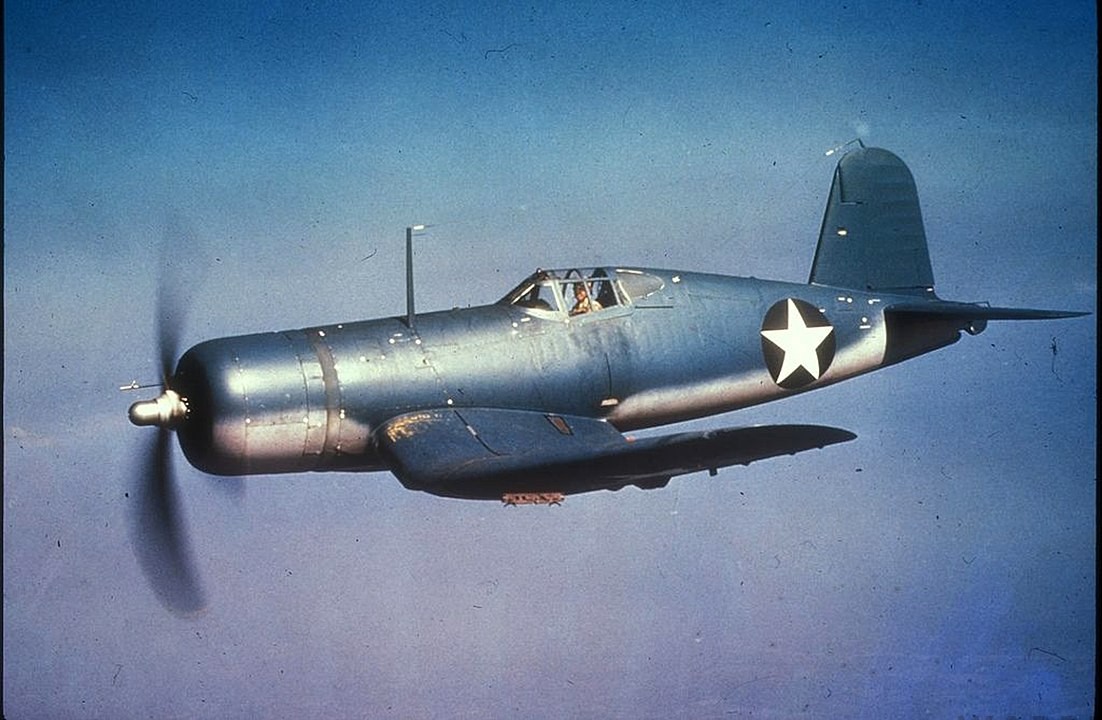On June 24, 1942, the first production Vought-Sikorsky F4U-1 Corsair, Bu. No. 02155, made its first flight at Stratford, Connecticut (some sources indicate June 25, 1942).
The Corsair was designed by Rex Buren Beisel, and is best known for its distinctive inverted “gull wing,” which allowed sufficient ground clearance for its 13 foot, 4 inch (4.064 meter) diameter propeller, without using excessively long landing gear struts. The prototype XF4U-1, Bu. No. 1443, had first flown 29 May 1940, with test pilot Lyman A. Bullard in the cockpit.

Vought’s own production began slowly, partially due to the number of changes implemented before the program began: the cockpit was moved 3 feet aft to accommodate more fuel and the engine bay was redesigned to accommodate the up-dated R-2800-8 engine, providing 2,000 horsepower on take-off. The first production Corsair was flown June 25, 1942. The Navy accepted its first two production Corsairs in July 1942, with nine following in August. During 1943 the production rate saw a steady increase, exceeding 200 units by November 1943. The total monthly Corsair production rate peaked in May 1944 when the Navy accepted 254 F4U’s (Vought), 220 FG’s (Goodyear) and 122 F3A’s (Brewster), for a total of 596 aircraft.
A very noticeable change was introduced in November 1942 when the fifth production aircraft was modified to raise the pilots’ seat. This development brought about the frameless, clear-vision, “Bubble” canopy. This change became standard in all F4U’s. Other design changes included a new, improved landing gear oleo, a new tail-hook installation to prevent “skipping” on carrier landings, and a modified/redesigned tail hook.
In all, seven major changes were made to the F4U over a span of a year and a half. Each change necessitated considerable research, engineering and testing. One noticeable change was the addition of a small spoiler on the edge of the starboard wing to reduce the accelerated stalls and ensure stall warnings. The clipped wing version for use on the British carriers was designated the F4U-1A.
By the end of 1944, Chance Vought was turning out 300 Corsairs a month, or one complete airplane every 82 minutes. Vought built 2,814 of the F4U-1’s. ( source www.vought.org)
One of the most recognizable airplanes in history owing to its unique inverted gull wing design, the F4U remained in continual production from 1942 until 1952, with more than 12,500 examples of the aircraft delivered. One of the Navy and Marine Corps’ finest fighters, Corsairs shot down 2,140 Japanese aircraft during World War II and in the Korean War a Marine pilot became the first to down a MiG-15 jet while flying a propeller-driven aircraft.
Vought-Sikorsky designed the F4U Corsair around the Pratt & Whitney R-2800 engine in a quest to build a fighter plane of unparalleled power and performance. The size of the engine necessitated a long nose and the aircraft featured inverted gull wings and tall landing gear in order to accommodate its oversized propeller. The result was an airplane that could eclipse 400 mph.
There were downsides to the design, however. The long nose necessitated a cockpit placement far back in the fuselage, which resulted in poor visibility during landing approaches. The plane also exhibited adverse stall characteristics at slow approach speeds, and a tendency to bounce on landing. These factors delayed introduction to carrier service, leaving it to Marine land-based squadrons to introduce the aircraft to combat in February 1943. Among the notable squadrons that flew the airplane from island airstrips were Fighting Squadron (VF) 17, nicknamed the Jolly Rogers, which shot down 152 Japanese aircraft, and Marine Fighting Squadron (VMF) 214, the famed Black Sheep commanded by Medal of Honor recipient Major Gregory “Pappy” Boyington. Eventually, the aircraft’s problems aboard ship were solved, the solutions in some cases attributed to British Royal Navy pilots who flew export versions of the Corsair. This allowed for assignment of Navy and Marine Corps squadrons to aircraft carriers in the latter part of World War II.
In the hands of American Naval Aviators, Corsairs accounted for 2,140 Japanese aircraft shot down in World War II, and the sound the aircraft made when it was flying close air support missions during island campaigns inspired the Japanese to call the plane “Whistling Death.” Still in service with both Navy and Marine squadrons during the Korean War, the aircraft proved itself still capable at close air support and ground attack. In addition, Marine Captain Jesse Folmar flew a most unusual mission in the skies over Korea, becoming the first piston-engine pilot to down a MiG-15 jet in air-to-air combat.
All told, three manufacturers (Vought, Brewster and Goodyear) delivered more than 12,500 F4Us in 13 production versions during the period 1942-1952, the longest production of any World War II fighter. The aircraft also flew in the military forces of six foreign nations, including France, which employed them in the campaigns in French Indochina [later Vietnam]. Source www.history.navy.mil
Don’t miss our THREE CORSAIR BUNDLE, only few left. Get it before it’s too late! Click the image below.


































